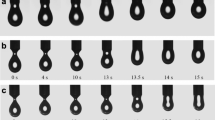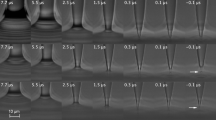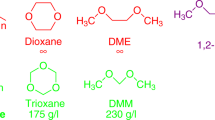Abstract
AMPHIPHILIC molecules such as detergents or lipids, which contain a hydrophilic 'head' and a hydrophobic 'tail' are capable of forming a wide variety of complex structures, including micelles, vesicles, bilayers, monolayers and liquid crystalline structures. This property is essential in many biological processes and is exploited in industrial and domestic applications, but remains poorly understood at a molecular level. Here we present the results of computer simulations of a molecular model for an oil-water-surfactant system. Micelles form spontaneously in the water phase and a monolayer of surfactants forms at the oil/water interface. A depletion layer, containing only water, separates this monolayer from the micelles. The density profiles of the micelles and the water show pronounced oscillations, which result from packing constraints on the micelles near the interface. These oscillations in the water density profile furnish a possible explanation of the results of neutron reflectivity experiments on water-surfactant systems.
This is a preview of subscription content, access via your institution
Access options
Subscribe to this journal
Receive 51 print issues and online access
$199.00 per year
only $3.90 per issue
Buy this article
- Purchase on Springer Link
- Instant access to full article PDF
Prices may be subject to local taxes which are calculated during checkout
Similar content being viewed by others
References
Telo da Gama, M. M. & Gubbins, K. E. Molec. Phys. 59, 227–239 (1986).
Smit, B. Phys. Rev. A37, 3431–3433 (1988).
Smit, B., Schlijper, A. G., Rupert, L. A. M. & van Os, N. M. J. phys. chem. 94, 6933–6935 (1990).
Larson, R. G. J. chem. Phys. 89, 1642–1650 (1988).
Larson, R. G. J. chem. Phys. 91, 2479–2488 (1989).
Alder, B. J. & Wainwright, T. E. J. J. chem. Phys. 27, 1208–1209 (1957).
Frenkel, D., Lekkerkerker, H. N. W. & Stroobants, A. Nature 332, 822–823 (1988).
Hayter, J. B. in Physics of Amphiphiles (ed. Degiorgio, V.) 59–93 (North-Holland, Amsterdam, 1985).
Tarazona, P., Marini Bettolo Marconi, U. & Evans, R. Molec. Phys. 60, 573–595 (1987).
Israelachvili, J. N. Intermolecular and Surface Forces (Academic, London, 1985).
Watanabe, K., Ferrario, M. & Klein, M. L. J. phys. Chem. 92, 819–821 (1988).
Szleifer, I., Ben-Shaul, A. & Gelbart, W. M. J. phys. Chem. 94, 5081–5089 (1990).
Lee, E. M., Thomas, R. K., Penfold, J. & Ward, R. C. J. phys. Chem. 93, 381–388 (1989).
Lee, E. M., Simister, E. A., Thomas, R. K. & Penfold, J. Colloq. phys. C50, 75–81 (1989).
Author information
Authors and Affiliations
Rights and permissions
About this article
Cite this article
Smit, B., Hilbers, P., Esselink, K. et al. Computer simulations of a water/oil interface in the presence of micelles. Nature 348, 624–625 (1990). https://doi.org/10.1038/348624a0
Received:
Accepted:
Issue Date:
DOI: https://doi.org/10.1038/348624a0
This article is cited by
-
Calibration and validation of coarse-grained models of atomic systems: application to semiconductor manufacturing
Computational Mechanics (2014)
-
Structure and solvation properties of aqueous sulfobetaine micelles in the presence of organic spin probes: a Molecular Dynamics simulation study
Structural Chemistry (2013)
-
Fluorescence spectroscopy and molecular dynamics simulations in studies on the mechanism of membrane destabilization by antimicrobial peptides
Cellular and Molecular Life Sciences (2011)
Comments
By submitting a comment you agree to abide by our Terms and Community Guidelines. If you find something abusive or that does not comply with our terms or guidelines please flag it as inappropriate.



